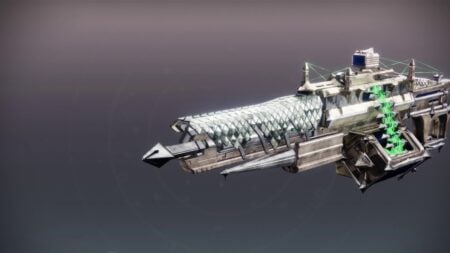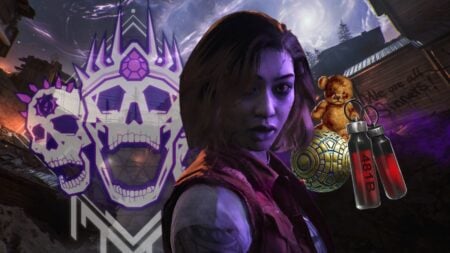Skip To...
The Lampbearer walks in two worlds, and so does Lords of the Fallen. It’s as pure a Soulslike as anything by Miyazaki, yet LotF isn’t content to merely copy, even from the best. It unites the old and familiar with the new and innovative, allowing players to switch stances mid-combo, snatch enemies’ souls from their bodies, and even traverse the land of the dead. The Lampbearer is a wretched creature but a glorious one. The same can be said of this game. Though its faults are undeniable, players who endure them will be rewarded with one of the best games in the genre and a name worth speaking alongside the likes of Dark Souls and Elden Ring.
Lords of the Fallen Review: Soulslike Reborn

The wretched land grows more wretched every day under the influence of the demon god Adyr. Only the Dark Crusader and their allies can claw back the light. To do so, you must explore the lands of the living and the dead, discover their secrets, and test your spells and steel against brutal bosses. This Soulslike takes no pity on the foolhardy or impatient. Only defeat will hone you into the weapon you must become. Multiple classes, branching paths, and a huge arsenal of weapons allow you to craft your character and playstyle however you’d like. PvP and co-op opportunities combine with deep combat to give you every reason to keep coming back after each bitter defeat.
Story: A Demon’s Work

After eons of terrorizing the land, the demon god Adyr was at last exiled. Now, his malign influence has resurfaced, and his demonic armies have returned. As the Dark Crusader, it is your grim duty to cleanse the five beacons perverted by Adyr’s influence and rid the land of the demon’s sway once more. There will inevitably be players who are only here for the combat and need no deeper backstory than “you have to stop a demon god,” but others will want to dig into the lore, and there’s a lot to dig through.
The Umbral Lamp is one of the primary mechanics that set Lords of the Fallen apart from other Soulslikes, and it plays a prominent role in the story too. How you come to be in possession of this magical artifact is an interesting tale, but it matters less than what you do once you have it. Under its baleful light, Axiom gives way to Umbra, revealing the secret wretchedness of the land of the dead. The skeletons of skyscraper-sized giants lean against cliffs, and masses of twisted flesh block passage through ruined castles. It’s a far richer world than its generic outline suggests.
As you explore Umbra, you will discover Stigmas: memories and traumas frozen in place like wax figures. You can use your Umbral Lamp to awaken these Stigmas, learning more about the story and gaining valuable resources in the process. You may recover a rusted sword from a rotten corpse and then hours later encounter a fragment of lore that explains more about the hero it once belonged to. Environmental storytelling combines with dialog, and boss fight cutscenes to create a hideous tapestry one stitch at a time.

The lore attached to items and Vestiges is excellent. Dialog, meanwhile, is hit or miss. Though the voice actors are talented, they’re let down by inconsistent writing. Weaving a fragmented Soulslike narrative is admittedly tough, and it’s even harder when you’re trying to preserve some twists. The result is dialog that’s more vague than compelling. That said, if you’re primarily interested in piecing together its story, Lords of the Fallen gives you a steady drip of information to keep lore hounds speculating and salivating.
The route to each beacon is anything but simple, and even finding your way is a challenge. There’s no world or minimap, just scattered journal pages with drawings pointing to major locations. You’ll need to study these closely if you want to identify the statues, crumbling temples, and other landmarks that dot the path to your ultimate goal. Each of the five biomes tells a coherent and intriguing tale, culminating in a climactic confrontation against the region’s boss. If you want answers, you’ll have to work for them, but LotF is quick to reward your efforts.
Locked doors, hidden passages, secret ladders, and frequent double-backs complicate the journey. This design encourages hands-on engagement with the story: understanding the world is one of the best ways to learn to navigate a Soulslike, after all. The actual mechanics of journeying through Lords of the Fallen‘s world consistently turn your attention back to the lore and keep it there. Though minor NPCs are sometimes forgettable, the game does a good job of imbuing even the least of them with heart and interest.
Gameplay: Soulslove

Lords of the Fallen has my favorite Soulslike combat outside of Elden Ring. From the HUD to the leveling system, the similarities run deep. Yet similarities to the genre’s most popular titles don’t prevent LotF from establishing a unique identity. Movement feels more fluid here than it does in most of its competitors, thanks in part to an emphasis on artful dodging rather than roll spamming. Every weapon type feels distinct and worthwhile, and spellcasting is not only viable but also enjoyable. Get stuck on a tough boss, and you can always summon an NPC or another player to help.
The differences between a sword and board Hallowed Knight, bow-wielding Blackfeather Ranger, or spell-slinging Pyric Cultist are significant, and combat options are diverse and rewarding. One of the best parts of combat in LotF is the ability to transition seamlessly from one stance to another mid-combo. Open with a two-handed swing of your hammer before shifting to your shield to shrug off a crushing blow. Combat in Lords of the Fallen makes it impossible for me to go back to many of the genre’s other titles.
There are many locations in which you’ll be fighting half a dozen mobs at once, sometimes in cramped caverns or on treacherous cliff ledges. It gives the game a different rhythm and requires different strategies than other Souls games. Some players will inevitably grow weary of the hordes of enemies and decide to rush from one Vestige to another rather than battle the crowds. Others will accept Lords of the Fallen for what it is and adopt a more tactical approach. It’s a game that savagely punishes your mistakes. As a result, your triumphs, when they finally come, are all the more rewarding.

There are dozens of bosses, and you never know what kind of opponent you’ll be facing. Each fight is a blast and always rewards you with a cool new weapon, spell, or other trinket. Is a boss stomping you? Semi-open level design means you can always go somewhere else, level up, and improve your equipment before returning. Timing and pattern recognition are paramount in this Soulslike. Even with high levels and upgraded equipment, you can expect to die dozens of times if your tactics and execution aren’t on point.
Rip your enemy’s soul out and carve it to bits, or simply throw it off a ledge and watch the body follow moments later. The Umbral Lamp is a big part of what makes combat in LotF unique. Some bosses can be Soulflayed, others are immune. Some enemies are infected with parasites that must be purged before they can be killed. Over time, you’ll collect eyes that you can use to upgrade your Umbral Lamp in unique ways, further expanding your options in combat.
If you die in Axiom, you’ll rise again in Umbra. Die in Umbra, and you’ll drop any Vigor you’ve collected and be sent back to the last Vestige you touched. The stakes only get higher in PvP. Whether you want to help other Lampbearers or invade their worlds, LotF offers solid incentives for multiplayer. One of the most common is Tints, which can be used to dye your armor and create a custom look. Combined with the game’s already impressive variety of weapons and armor, the fashion scene in Lords of the Fallen is spectacular.
Graphics & Audio: Putrid Perfection

Your opponent wears an iron mask, a crude cage of spikes that hides his face and muffles his cries. As the berserker drives himself into a frenzy, your hopes of escape grow thin. You tuck away your shield and put both hands on your sword, a rusted shard of steel wrapped in barbed wire. One misstep and you’ll tumble off the wooden scaffolding of the Tower of Penance. Below, there’s a long drop before you’d hit iron and blood. Lords of the Fallen is a game of ugly things presented beautifully.
On the surface, environmental design is one of the areas in which LotF deviates least from the Soulslikes formula. Imposing mountains, dripping caverns, crumbling castle ruins, and poisonous swamps are all on display. LotF is classic dark fantasy. Umbra is as bleak and grotesque as you’d expect from the land of the dead. Even Axiom, the land of the living, shows the scars of cruelty and war. If medieval Europe is the game’s first visual inspiration, Silent Hill is arguably its second.

However bad Axiom is, Umbra is worse. You raise your Lamp, and the world transforms under its blue glow. Pale and sticky growths creep along the walls. Tumors erupt from the hills and buildings. There are bodies everywhere, frozen in positions of terror or death. They look waxy and soft, as if molded from the same candles you find all around them. A mass of tentacles blocks the path ahead. At the center of that mass is a single, roving eye. It’s a unique and disturbing visual style that sets it apart from its competition.
One of Lords of the Fallen‘s greatest achievements is its cohesive visual and audio design. Whether you’re in a forest or on a mountaintop, in Axiom or Umbra, it all feels coherent and immersive. There are minor graphical issues, such as clothing and armor clipping through one another. The sounds of weapon impacts also vary in quality, unfortunately. Main bosses are visual spectacles, and even side bosses are visual and auditory treats. Overall, the handful of visual and auditory flaws aren’t enough to hold LotF back.
Conclusion: Scarred Beauty

Lords of the Fallen is brilliant in so many ways that its few serious issues are truly crushing. The first problem is stuttering, an infrequent issue mostly limited to one mountainous region. My 3080 graphics card didn’t help, and changing my settings didn’t either. The far bigger problem is crashing. My game crashed almost two dozen times during my playthrough, including once during a major boss fight. It’s an issue that Hexworks will likely fix, but until the developer does, LotF will suffer.
How enjoyable PvP and co-op will be in the long term remains to be seen. The challenging bosses and single-player experience, however, are deep enough to warrant multiple playthroughs. Add to that depth the many possible challenge runs, and the game’s longevity skyrockets. If Hexworks can fix the game’s stability and stuttering issues, this will be something special. As is, Lords of the Fallen ranks amongst the best Soulslikes. There’s so much to like about Lords of the Fallen that it’s easy to recommend, even in its current form. It’s an homage to the best of the genre but never resorts to mere imitation. Walk in light, Lampbearer. Adyr is watching.
Lords of the Fallen will be available for PC, PlayStation 5, and
Lords of the Fallen (PC Reviewed)
An innovative yet familiar Soulslike with a captivating world, marred by performance issues.
Pros
- Gorgeous dark fantasy setting
- Great weapon and armor variety
- Satisfying mobs and bosses
Cons
- Severe stuttering and frequent crashes
- Inconsistent pacing
- Too many mobs overall







